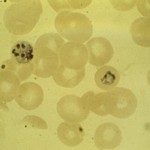Link to Pubmed [PMID] – 23910910
Cell. Microbiol. 2014 Jan;16(1):50-63
Plasmodium falciparum invades host erythrocytes by multiple invasion pathways. The invasion of erythrocytes by P. falciparum merozoites is a complex process that requires multiple interactions between host receptors and parasite ligands. A number of parasite proteins that mediate interaction with host receptors during invasion are localized to membrane-bound apical organelles referred to as micronemes and rhoptries. The timely release of these proteins to the merozoite surface is crucial for receptor engagement and invasion. It has been demonstrated previously that exposure of merozoites to a low potassium (K(+)) ionic environment as found in blood plasma leads to a rise in cytosolic calcium (Ca(2+)), which triggers microneme secretion. The signalling pathways that regulate microneme discharge in response to rise in cytosolic Ca(2+) are not completely understood. Here, we show that a P. falciparum Ca(2+)-dependent protein phosphatase, calcineurin (PfCN), is an essential regulator of Ca(2+)-dependent microneme exocytosis. An increase in PfCN activity was observed in merozoites following exposure to a low K(+) environment. Treatment of merozoites with calcineurin inhibitors such as FK506 and cyclosporin A prior to transfer to a low K(+) environment resulted in inhibition of secretion of microneme protein apical merozoite antigen-1 (PfAMA-1). Inhibition of PfCN was shown to result in reduced dephosphorylation and depolymerization of apical actin, which appears to be criticalfor microneme secretion. PfCN thus serves as an effector of Ca(2+)-dependent microneme exocytosis by regulating depolymerization of apical actin. Inhibitors that target PfCN block microneme exocytosis and limit growth of P. falciparum blood-stage parasites providing a novel approach towards development of new therapeutic strategies against malaria.
